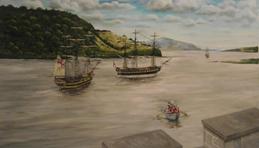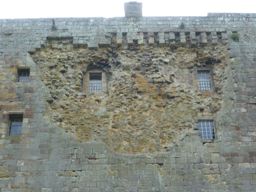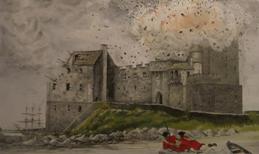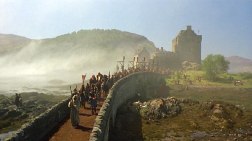How Eilean Donan Castle Nearly Shrugged off the Age of Gunpowder (Then Got Blown up Anyway)

(Picture courtesy of Matthew Ryan)
AD 1719, the wild West Coast of Scotland, where nobody seems to realise that the Viking Age is over, and three government frigates close in on Eilean Donan Castle.
How’s this going to go?
Eilean Donan Castle — which was once famously defended by just two men, one a good archer — has a Spanish garrison of 46 soldiers. They’re here to guard a depot for munitions shipped in to support yet another Jacobite uprising.
Jacobite means “supporters of James,” in this case James Stuart, son of the deposed King James II Stewart, last of king of the Scottish dynasty deposed in favor of a Hanoverian-as-in-German one. Most Scots then and now don’t get too romantic about the Stuarts. Once they became kings of the United Kingdom, the Stuarts didn’t do much for their former countrymen, and once deposed, they mostly got them killed.
And it’s not that the Spanish government particularly likes the Stuarts. It’s just that Spain is on the other side from the British in something called the War of the Quadruple Alliance, so stirring up trouble is part of the game.

(Kim Traynor via Wikimedia)
So, frigates versus castle.
It’s looking to be one of those comedy moments, like the whale in Hitchhiker’s Guide to the Galaxy. As everybody who has ever watched the History Channel knows, gunpowder spelled the end of the age of the castle.
Except, actually, it didn’t.
True, during the period that gunpowder artillery became more effective, say 1300-1550, we see fewer castles built, and the royal ones evolve into sophisticated gun forts.
However, the story isn’t simple. In lawless, inaccessible areas, people continue to build traditional-looking castles right into the 17th century. For example, if you tour the Anglo-Scottish marches, you’ll find dozens of “pele towers” or “towerhouses” — basically big rectangular towers — and few of them dating earlier than the 16th century.
What’s actually happening [according to the Osprey Castles and Tower Houses of the Scottish Clans 1450-1650 (Fortress)] is that there’s now no point in anybody who is not also a government trying to withstand a siege by government forces anywhere where a cannon can be hauled in. Take for example Borthwick Castle, really just a Lowland Scottish towerhouse on steroids.
Wonderful Medieval stronghold. Surrendered to Cromwell after a few cannon shots.

(Picture courtesy of Matthew Ryan)
However, in lawless areas, which is almost everywhere north of the Tyne, landowners still need to be safe from bandits, political rivals, and families with whom they are at feud. These people have muskets and cold steel, but no cannon, so a retro towerhouse does fine.
The same goes for inaccessible areas like the Scottish West coast.
They’re lawless anyway, so there’s a clear need for fortified dwellings. However, the inaccessibility that fosters the lawlessness also makes it hard for the government to bring up siege trains. The Osprey book gives the minimum requirement as one 12-pounder cannon — not small! — plus a brass mortar piece with 74 rounds of ball and powder and hence 2 four-wheeled wagons, 10 carts, 67 men, and a support team of about 100 men.
You’d also need a small army to protect them. And supplies. (If you think that’s practical for the West Coast of Scotland, go explore using Google Streetview and come back.)
So it was that in the early 18th century, it was not entirely foolish for the garrison of Eilean Donan Castle to hold out against government forces.

The frigates bombarded the castle for an hour, then gave up. It turned out that though they were well-equipped for battering other wooden ships into submission, they were not so good at knocking chunks out of thick masonry.
The next day, the cannons were reduced to providing cover for a successful infantry. Musket and bayonet, not cannon, carried the castle.
The victors then used the munitions held within to reduce the place to rubble.
If you hop over to the CANMORE website, you can view digital images of the castle before and after restoration courtesy of the Royal Commission on the Ancient and Historic Monuments of Scotland.
The bridge, of course, is a 20th century addition…
M Harold Page (www.mharoldpage.com) is a Scottish-based writer and swordsman with several Historical Adventure franchise books in print. His creative writing handbook, Storyteller Tools is available on Amazon.
i swear i’ve seen Eilean Donan Castle in a movie but i can’t remember which one.
The castle is featured in the movie Maid of Honor with Patrick Dempsey…I’ve embarrassed myself now.
Best known for Highlander, I think. I remember we used to joke about it having a carpark in the basement – result of the way they cut the scenes in the film.
Think it was in Highlander as well as the castle at the end of Monty Python’s Holy Grail